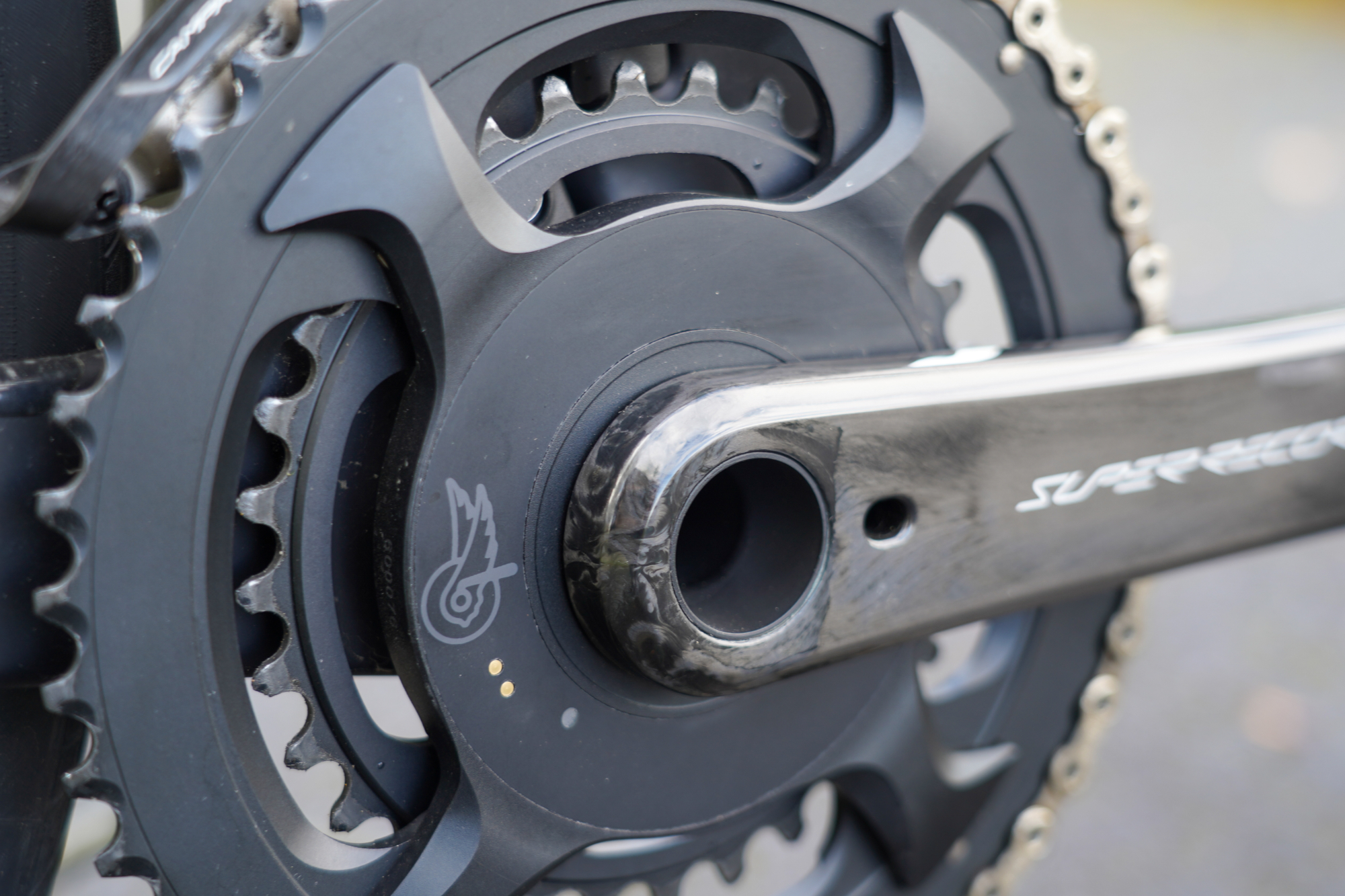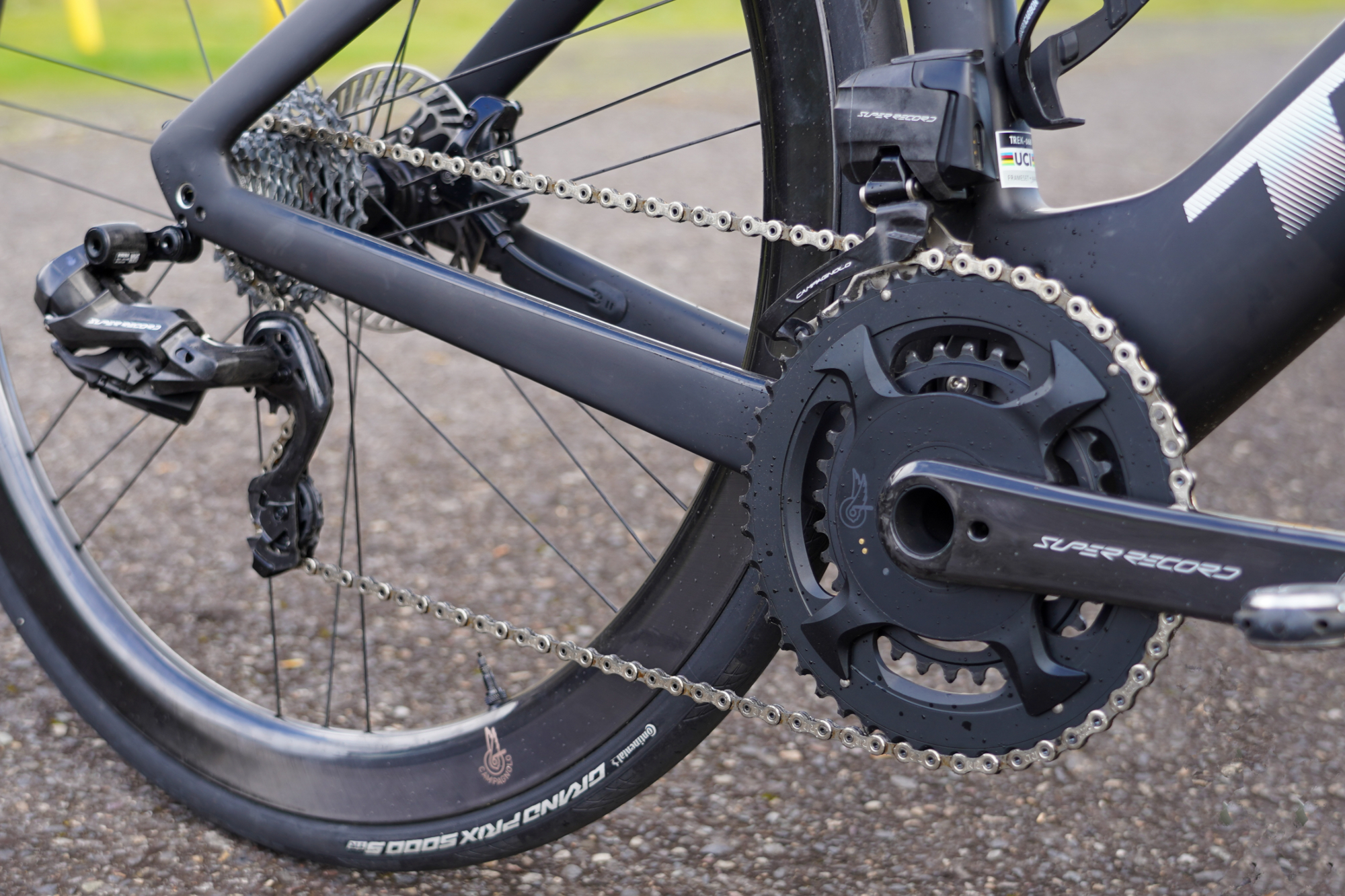Campagnolo enters the power meter market the only way it knows how: with a $2400 crank-based power meter — which, of course, we had to get our hands on
Outpricing its drivetrain rivals by at least a grand, what can Campy offer that’s worth such a price tag?


The long-awaiting Campagnolo power meter is finally here. The Italian drivetrain manufacturer filed for a patent for its first crank-based power meter back in 2020, and we've been eagerly awaiting the reveal ever since. Patent drawings aside, an actual Campagnolo HPPM crankset first broke cover at the UCI Cyclocross World Championships earlier this year aboard Dutchman Ryan Kamp's bike. Thus, a public release could not be far off.
An in-house power meter has been a noticeable gap in Campagnolo's product offerings, as its main rivals –Shimano and SRAM—have long integrated in-house power meters into their groupset offerings.
After acquiring Quarq in 2011, SRAM was the first to release its in-house power meter, the SRAM RED Quarq spindle in 2014. Shimano followed in 2016 with the unveiling of the Shimano FC-R9100-P power meter, which was integrated into the band's Dura-Ace R9100 series crankset. Meanwhile, Campagnolo consumers relied on third-party options like SRM and Stages for their power data.
There was some surprise last year when Campagnolo released its new, 12-speed Campagnolo Super Record Wireless groupset, which, despite being the most expensive mass-market groupset ever to be released at $5,399/£4,499, still did not include a power option. But now here we are.
At a time when SRAM is pushing power meters for the masses with its 2023 release of a $300 Apex-level crank-based power meter (albeit a single-sided one), Campagnolo is going after the opposite pointy end of the market with the unveiling of the HPPM (High Precision Power Measurement) power meter, a crank-based measuring device that's part of the brand's Super Record line-up and comes with the staggering price tag of $2,449 / £1.949,00 / €2,240.
Cycling Weekly was among the very few to get our hands on the crankset pre-release to experience the now complete top-end Campagnolo Super Record package, consisting of the fully wireless shifting technology, power meter crankset, and even the newly released Bora Ultra WTO wheelset.
Introducing: The Campagnolo HPPM Power Meter

Campagnolo says designing the power meter took "extensive research and analysis" and that its introduction today isn't just about completing the brand's product line-up, it's a "commitment to delivering supremely accurate data to enhance training and racing for passionate riders".
The latest race content, interviews, features, reviews and expert buying guides, direct to your inbox!
To measure this data, Campagnolo opted for a spider-based power meter, with the measuring device located between the crankarm and chainrings. Spider-based power meters offer several benefits, from protection of wear to, most importantly, the ability to capture complete dual-sided power measurements.
Campagnolo's HPPM features 16 sensors (called strain gauges) strategically placed in the crankarms to detect torque values throughout the pedal stroke. This data is then paired with real-time angular velocity data provided by the crankset's built-in gyroscope. The power meter measures the angular velocity and torque signals every five milliseconds which, when translated through a tailored algorithm, boasts a claimed accuracy level within +/- 1%.

The power meter is housed in Campagnolo's 'Ultra-Torque' crank system, which the brand says is its 'most advanced system for translating the rider's organic power to output.' As seen in the existing Super Record crankset, this system makes use of a unidirectional carbon fiber crankarms and a titanium axle for efficient power transfer. However, the power meter's spider appears to be made of alloy.
The HPPM communicates with your phone or head unit via Bluetooth and ANT+, and makes use of the same magnetic charging connector as the other Campagnolo wireless components. Fully charged, the power meter is said to last "over a month," whatever that may be, and can be recharged completely in under four hours.
The HPPM crankset is available in a 2x12 configuration with crankarms of 170mm, 172.5mm, or 175 mm and three chainring configurations: 45-29, 48-32, and 50-34.
Campagnolo's latest phone app, My Campy 3.0, is set to receive a software update to track battery status and make system calibration and updates a user-friendly experience.
The Competition
| B | Accuracy | Battery Type | Battery Life | Price |
|---|---|---|---|---|
| SRAM Red AXS | +/- 1.5% | Coin cell | 200 ride hours | $1,291 |
| Shimano Dura-Ace R9200-P | +/- 1.5% | Integrated | 300+ ride hours | $1,299 - $1,755 |
| Campagnolo HPPM | +/- 1% | Integrated | "over a month" | $2,449 |
The Campagnolo power meter significantly out-prices its drivetrain rivals – and one could easily buy two mid-tier power meter-equipped cranksets or power pedals for that money. Should you want to buy a Campagnolo Super Record Wireless groupset with the new power meter crank included, you're looking at a price tag of $6890 / €6290.
When asked what the consumer gets for that extra $1200, Campagnolo pointed to the promise of an 'unrivaled level of accuracy,' a 'best-in-class spider geometry,' the 'extreme efficiency' of the Ultra-Torque technology, and the 'highest standard of product finishing and eye-catching design' Campagnolo is known for. Or simply said, "the best riding experience."
Indeed, with the claimed accuracy level of +/- 1, it does provide a better claimed accuracy level than its Shimano and SRAM competitors and places itself among the power meter specialists like Power2Max and SRM.
The eye-catching design and finish is, of course, highly personal though I'd agree that the exposed carbon aesthetic on the crankarms is quite stunning indeed.
Weighing in at just 656g (for 172.5mm cranks arms and 45x29 rings), the crankset is also quite light. Around 100g lighter than the Dura Ace power meter but not quite as light as the SRAM Red AXS power meter crankset at 630 grams with 170mm crankarms and 50/37 rings.
The HPPM in use

To showcase its top-end product line, Campagnolo provided me with a Trek Madone SLR 9 frameset equipped with the new Super Record Wireless drivetrain, the HPPM power meter crankset, and the newly released Bora Ultra WTO wheelset wrapped in Continental 5000s. Ready to ride, the bike weighed in at just 15.5 pounds (7kg).
This WorldTour-ready package looked and made for an absolute rocket ship of a bike that has had me grinning from ear to ear on every outing. At well over $16K, it's also among the priciest mass-produced bikes I've ever ridden. Netting one Strava Personal Best after another, the bike made me remember how much fun all-out race bikes can be.
Campagnolo mentions its "eye-catching design" and superior product finishes as reasons why it stands out from its competitors, and I agree with that. The Italian flare does look luxurious—especially now that it's rid itself of the old thumb shifter. The whole system is also remarkably quiet. No freehub sound, no clunky shifting - pure stealth.

The electronic groupset blinks its blue light frequently, while the HPPM power meter lets you know it's ready to go via two yellow lights in the center of the spider. Like the rest of the Super Record groupset, the HPPM power meter was quick to communicate with my Garmin head units and phone.
Sadly, my outings on this purebred racer have been but few and, of course, with testing in mind. As such, I've been riding around with dual computers and power meters to compare the ride data.
I've been comparing the Campagnolo HPPM crankset-based power data with the results of both Garmin's and Wahoo's dual-sided pedal-based power meters – both of which also carry a claimed accuracy rate of +/- 1.0% (and because I've yet to figure out how to run two crankset-based power meters simultaneously).
Before I share my initial impressions, it's important to preface that we received this test unit pre-release and as such, the My Camp 3.0 app has yet to receive its update in order to recognize the power meter. Thus, we could not conduct any in-app calibration, should that be required. In our experience, however, most modern spider- or crankset-based power meters get zeroed out after assembly and installation \in the factory and should not need pre-ride calibrations, but it could certainly play a factor in these initial findings. I have also not done an indoor test where I can compare the HPPM's data to that of a Kickr.

Campagnolo HPPM (colors) vs Garmin Rally power pedals (grey)
During my time with the Campagnolo-equipped bike, I rode my usual loops at a normal, ride-by-myself pace, and I conducted a hill-repeat session as well. Compared to both pedal-based power meters, the Campagnolo meter consistently read higher than the power pedals. On the full-ride power averages, the discrepancies averaged an astonishing 15% difference between the HPPM data and the power pedal data. On max power data, the discrepancies were smaller at an 8.7% difference on average. However, the cadence data as well as the Left and Right Power Balance data was almost identical.

Campagnolo HPPM (colors) vs Wahoo Power Pedals (grey)
The discrepancies are larger than we would expect to see between power meters. However, as stated, calibration could be a factor here, and this can't be verified until the app is ready to use.
I look forward to interacting with the power meter through the app upon release and to see if that brings those numbers any closer, and will provide a longer term review once I've had a chance to log some more miles with a calibrated power meter.

Cycling Weekly's North American Editor, Anne-Marije Rook is old school. She holds a degree in journalism and started out as a newspaper reporter — in print! She can even be seen bringing a pen and notepad to the press conference.
Originally from the Netherlands, she grew up a bike commuter and didn't find bike racing until her early twenties when living in Seattle, Washington. Strengthened by the many miles spent darting around Seattle's hilly streets on a steel single speed, Rook's progression in the sport was a quick one. As she competed at the elite level, her journalism career followed, and soon, she became a full-time cycling journalist. She's now been a journalist for two decades, including 12 years in cycling.